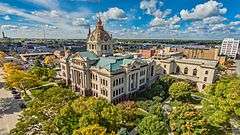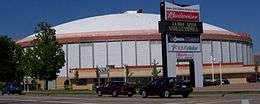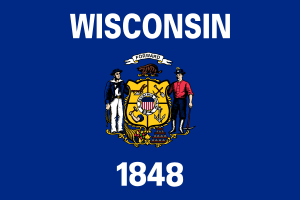Brown County, Wisconsin
| Brown County, Wisconsin | |
|---|---|
 Brown County Courthouse in Green Bay | |
 Location in the U.S. state of Wisconsin | |
 Wisconsin's location in the U.S. | |
| Founded | 1818 |
| Named for | Jacob Brown |
| Seat | Green Bay |
| Largest city | Green Bay |
| Area | |
| • Total | 616 sq mi (1,595 km2) |
| • Land | 530 sq mi (1,373 km2) |
| • Water | 86 sq mi (223 km2), 14% |
| Population | |
| • (2010) | 248,007 |
| • Density | 468/sq mi (181/km²) |
| Congressional district | 8th |
| Time zone | Central: UTC-6/-5 |
| Website |
www |
Brown County is a county in the U.S. state of Wisconsin. As of the 2010 census, the population was 248,007,[1] making it the fourth-most populous county in Wisconsin. The county seat is Green Bay.[2] Brown County is part of the Green Bay, WI Metropolitan Statistical Area.
History
Wisconsin Territory depicted on this 1835 Tourist's Pocket Map Of Michigan, showing a Menominee-filled Brown County, Wisconsin that spans the northern half of the territory.
Brown County is one of Wisconsin's two original counties, along with Crawford County. It originally spanned the entire eastern half of the state when formed by the Michigan Territorial legislature in 1818. It was named for Major General Jacob Brown,[3][4] a military leader during the War of 1812.
Geography
According to the U.S. Census Bureau, the county has a total area of 616 square miles (1,600 km2), of which 530 square miles (1,400 km2) is land and 86 square miles (220 km2) (14%) is water.[5]
Adjacent counties
- Oconto County – north
- Kewaunee County – east
- Manitowoc County – southeast
- Calumet County – southwest
- Outagamie County – west
- Shawano County – northwest
Major highways
Demographics
| Historical population | |||
|---|---|---|---|
| Census | Pop. | %± | |
| 1840 | 2,107 | — | |
| 1850 | 6,215 | 195.0% | |
| 1860 | 11,795 | 89.8% | |
| 1870 | 25,168 | 113.4% | |
| 1880 | 34,078 | 35.4% | |
| 1890 | 39,164 | 14.9% | |
| 1900 | 46,359 | 18.4% | |
| 1910 | 54,098 | 16.7% | |
| 1920 | 61,889 | 14.4% | |
| 1930 | 70,249 | 13.5% | |
| 1940 | 83,109 | 18.3% | |
| 1950 | 98,314 | 18.3% | |
| 1960 | 125,082 | 27.2% | |
| 1970 | 158,244 | 26.5% | |
| 1980 | 175,280 | 10.8% | |
| 1990 | 194,594 | 11.0% | |
| 2000 | 226,778 | 16.5% | |
| 2010 | 248,007 | 9.4% | |
| Est. 2015 | 258,718 | [6] | 4.3% |
| U.S. Decennial Census[7] 1790–1960[8] 1900–1990[9] 1990–2000[10] 2010–2014[1] | |||

2010 census
As of the census[11] of 2010, there were 248,007 people, 98,383 households, and 63,721 families residing in the county. The population density was 403 people per square mile (156/km²). There were 104,371 housing units at an average density of 170 per square mile (66/km²). The racial makeup of the county was 86.5% White, 2.2% Black or African American, 2.7% Native American, 2.7% Asian, 0.0004% Pacific Islander, 3.7% from other races, and 2.2% from two or more races. 7.3% of the population were Hispanic or Latino of any race.
There were 98,383 households out of which 31.0% had children under the age of 18 living with them, 50.0% were married couples living together, 10.2% had a female householder with no husband present, and 35.2% were non-families. 27.7% of all households were made up of individuals and 8.9% had someone living alone who was 65 years of age or older. The average household size was 2.45 and the average family size was 3.02.
In the county, the population was spread out with 24.1% under the age of 18, 10.8% from 18 to 24, 26.9% from 25 to 44, 26.6% from 45 to 64, and 11.6% who were 65 years of age or older. The median age was 36.2 years. For every 100 females there were 97.80 males. For every 100 females age 18 and over, there were 95.70 males.
2000 census
As of the census[11] of 2000, there were 226,778 people, 87,295 households, and 57,527 families residing in the county. The population density was 429 people per square mile (166/km²). There were 90,199 housing units at an average density of 171 per square mile (66/km²). The racial makeup of the county was 91.14% White, 1.16% Black or African American, 2.29% Native American, 2.18% Asian, 0.03% Pacific Islander, 1.90% from other races, and 1.30% from two or more races. 3.84% of the population were Hispanic or Latino of any race. 33.8% were of German, 8.9% Polish, 7.8% Belgian and 6.8% Irish ancestry according to Census 2000. 93.2% spoke only English at home, 3.8% spoke Spanish and 1.2% Hmong.
There were 87,295 households out of which 33.90% had children under the age of 18 living with them, 53.20% were married couples living together, 8.90% had a female householder with no husband present, and 34.10% were non-families. 26.50% of all households were made up of individuals and 8.40% had someone living alone who was 65 years of age or older. The average household size was 2.51 and the average family size was 3.08.
In the county, the population was spread out with 26.10% under the age of 18, 10.50% from 18 to 24, 31.90% from 25 to 44, 20.90% from 45 to 64, and 10.70% who were 65 years of age or older. The median age was 34 years. For every 100 females there were 98.90 males. For every 100 females age 18 and over, there were 96.90 males.
Government
The legislative branch of Brown County is the 26-member Board of Supervisors. Each member represents a single district and serves a two-year term, with elections held in the spring of even-numbered years. The Board of Supervisors elects a Chairman and Vice Chairman from its membership.
The executive branch of Brown County is the County Executive, who is elected in the spring of every other odd-numbered year. The executive appoints department heads with the approval of the County Board. The current county executive is Troy Steckenbach.
Brown County has several other elected officials that are established under the Wisconsin State constitution and are referred to as the "constitutional officers". Constitutional officers are the only partisan elected officials within Brown County government, as the Executive and County Board are non-partisan positions.
The current constitutional officers are:
- County Executive: Troy Streckenbach
- Clerk: Sandy Juno (R)
- Clerk of Circuit Courts: John Vander Leest (R)
- District Attorney: David L. Lasee (R)
- Register of Deeds: Cathy Williquette (D)
- Sheriff: John Gossage (R)
- Treasurer: Paul Zeller (R)
In July 2002, the county declared English its official language, voting 17-8 to do so and to increase spending to promote fluency in English.
Communities

Cities
Villages
- Allouez
- Ashwaubenon
- Bellevue
- Denmark
- Hobart
- Howard (partly in Outagamie County)
- Pulaski (partly in Shawano County and Oconto County)
- Suamico
- Wrightstown (partly in Outagamie County)
Towns
Census-designated places
Unincorporated communities
- Anston
- Askeaton
- Benderville
- Bay Settlement
- Buckman
- Champion
- Chapel Ridge
- Coppens Corner
- Fontenoy
- Edgewater Beach
- Glenmore
- Henrysville
- Hollandtown
- Humboldt
- Kolb
- Kunesh
- Langes Corners
- Lark
- Little Rapids
- Mill Center
- Morrison
- New Franken
- Pine Grove
- Pittsfield (partial)
- Poland
- Red Banks
- Shirley
- Sniderville (partial)
- Sugar Bush
- Wayside
- Wequiock
Native American communities
- Oneida Nation of Wisconsin (partial)
Ghost towns/Neighborhoods
See also
References
- 1 2 "State & County QuickFacts". United States Census Bureau. Retrieved January 17, 2014.
- ↑ "Find a County". National Association of Counties. Archived from the original on 2011-05-31. Retrieved 2011-06-07.
- ↑ History of the Origin of the Place Names in Nine Northwestern States. 1908. p. 12.
- ↑ "Here's How Iron Got Its Name". The Rhinelander Daily News. June 16, 1932. p. 2. Retrieved August 24, 2014 – via Newspapers.com.

- ↑ "2010 Census Gazetteer Files". United States Census Bureau. August 22, 2012. Retrieved August 2, 2015.
- ↑ "County Totals Dataset: Population, Population Change and Estimated Components of Population Change: April 1, 2010 to July 1, 2015". Retrieved July 2, 2016.
- ↑ "U.S. Decennial Census". United States Census Bureau. Archived from the original on May 11, 2015. Retrieved August 2, 2015.
- ↑ "Historical Census Browser". University of Virginia Library. Retrieved August 2, 2015.
- ↑ Forstall, Richard L., ed. (March 27, 1995). "Population of Counties by Decennial Census: 1900 to 1990". United States Census Bureau. Retrieved August 2, 2015.
- ↑ "Census 2000 PHC-T-4. Ranking Tables for Counties: 1990 and 2000" (PDF). United States Census Bureau. April 2, 2001. Retrieved August 2, 2015.
- 1 2 "American FactFinder". United States Census Bureau. Archived from the original on 2013-09-11. Retrieved 2011-05-14.
Further reading
- Commemorative Biographical Record of the Fox River Valley Counties of Brown, Outagamie and Winnebago. Chicago: J. H. Beers, 1895.
- Martin, Deborah B. History of Brown Country Wisconsin: Past and Present. 2 vols. Chicago: S. J. Clarke, 1913. Vol. 1 Vol. 2
External links
- Brown County website
- Brown County map from the Wisconsin Department of Transportation
- Northeast Wisconsin Historical County Plat Maps & Atlases
 |
Shawano County | Oconto County | Green Bay |  |
| Outagamie County | |
Kewaunee County | ||
| ||||
| | ||||
| Calumet County | Manitowoc County |
Coordinates: 44°29′N 87°59′W / 44.48°N 87.99°W
.jpg)

